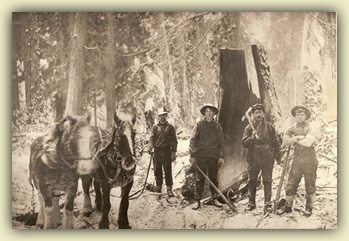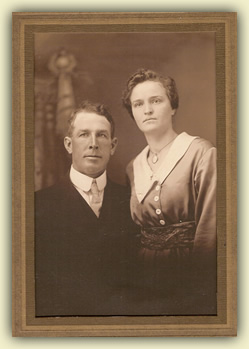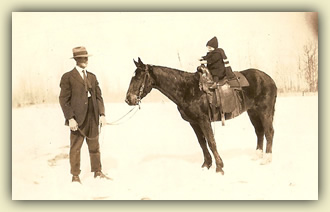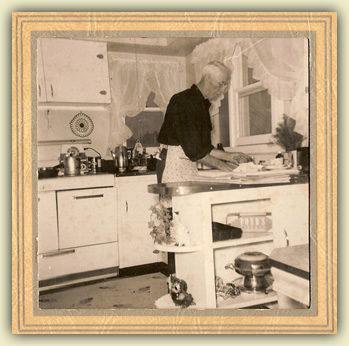For me, thinking of Kenneth McNeil is seeing my family's tradition of Scots ingenuity and fine craftsmanship extending backwards in time. He spent his youth in the logging industry, felling gigantic trees with hatchets and handsaws, but by the late 1920's he was working as a fine-finish carpenter on projects in the Portland area. In 1927-28 he contributed to the detailing of the Portland Publix Theatre, an elaborate Italiante vaudeville hall that opened in mirrored and velvet-draperied glory on the eve of the Depression, featuring fireplaces, ivory-and-gold grand pianos, and "the longest candy counter in the West." It was later to become the Paramount Movie Theater, and, still later, the Arlene Schnitzer Concert Hall.
 In the mid-1930's, Kenneth spent time in the Columbia Gorge, working on the construction of well-known Bonneville Dam. Then, as now, the Gorge was famous for its inhospitable weather; even more than half a century later, his daughter still remembered the icy cold fog and winds that used to buffet her parents' car when the family would bundle up to bring food and supplies out to Kenneth on the job. Both the Dam and the Theater (familiarly called the "Schnitz") are Portland-area landmarks to this day, and I feel lucky to have such a tangible connection to the city I call home, and to this man who shared my love of well-wrought details.
In the mid-1930's, Kenneth spent time in the Columbia Gorge, working on the construction of well-known Bonneville Dam. Then, as now, the Gorge was famous for its inhospitable weather; even more than half a century later, his daughter still remembered the icy cold fog and winds that used to buffet her parents' car when the family would bundle up to bring food and supplies out to Kenneth on the job. Both the Dam and the Theater (familiarly called the "Schnitz") are Portland-area landmarks to this day, and I feel lucky to have such a tangible connection to the city I call home, and to this man who shared my love of well-wrought details.
 Kenneth was the son of first-generation Scottish immigrants to Guelph, Ontario. He married my great-grandmother, Ethel Mildred Ferguson, and lived with her for a few years in rural Ontario before uprooting to Portland, Oregon in 1922. Images of their life in Toronto seem extremely rustic by modern standards. A photograph labeled "our first home" reveals a small house made of joined logs and surrounded by grasses; another shot depicts Ethel standing in front of the house with a shotgun and a dead bird. If Kenneth's later skills at carpentry were any indication, however, the little house may have been more snug and well-crafted than it appears. In any case, the couple soon moved to Oregon with their toddler son, Roddy, and in 1923 my grandmother, Betty Jean, was born.
Kenneth was the son of first-generation Scottish immigrants to Guelph, Ontario. He married my great-grandmother, Ethel Mildred Ferguson, and lived with her for a few years in rural Ontario before uprooting to Portland, Oregon in 1922. Images of their life in Toronto seem extremely rustic by modern standards. A photograph labeled "our first home" reveals a small house made of joined logs and surrounded by grasses; another shot depicts Ethel standing in front of the house with a shotgun and a dead bird. If Kenneth's later skills at carpentry were any indication, however, the little house may have been more snug and well-crafted than it appears. In any case, the couple soon moved to Oregon with their toddler son, Roddy, and in 1923 my grandmother, Betty Jean, was born.
 Sadly, Kenneth died in 1953, when my father was only two. Few first-hand memories of him have been passed on, but from the small amount of surviving evidence, he appears to have been a gifted artisan and a generous man. In an account book discovered by my father, Kenneth made notes about transactions in which he was involved. Many of them were favors done for friends or neighbors, carpentry tasks he jotted down, but for which he appears not to have expected repayment.
Sadly, Kenneth died in 1953, when my father was only two. Few first-hand memories of him have been passed on, but from the small amount of surviving evidence, he appears to have been a gifted artisan and a generous man. In an account book discovered by my father, Kenneth made notes about transactions in which he was involved. Many of them were favors done for friends or neighbors, carpentry tasks he jotted down, but for which he appears not to have expected repayment.
 It was this spirit of understated craftsmanship and generosity that I tried to capture with the Kenneth sweater. The diamond stitch pattern found on the back and fronts is a traditional Scottish colorwork design, rendered in raised purl stitches rather than contrasting hues. In the purl design that runs along the sleeves, I developed my own variation on this diamond theme. The saddle shoulders were designed to mimic the snug, secure fit of a dovetail joint, bringing to mind Kenneth's long career of artful carpentry, while the subtle, oceanic color play of Rowan’s Felted Tweed evokes both cloudy Scottish skies and the tenacious Gorge fogs near Bonneville.
It was this spirit of understated craftsmanship and generosity that I tried to capture with the Kenneth sweater. The diamond stitch pattern found on the back and fronts is a traditional Scottish colorwork design, rendered in raised purl stitches rather than contrasting hues. In the purl design that runs along the sleeves, I developed my own variation on this diamond theme. The saddle shoulders were designed to mimic the snug, secure fit of a dovetail joint, bringing to mind Kenneth's long career of artful carpentry, while the subtle, oceanic color play of Rowan’s Felted Tweed evokes both cloudy Scottish skies and the tenacious Gorge fogs near Bonneville.